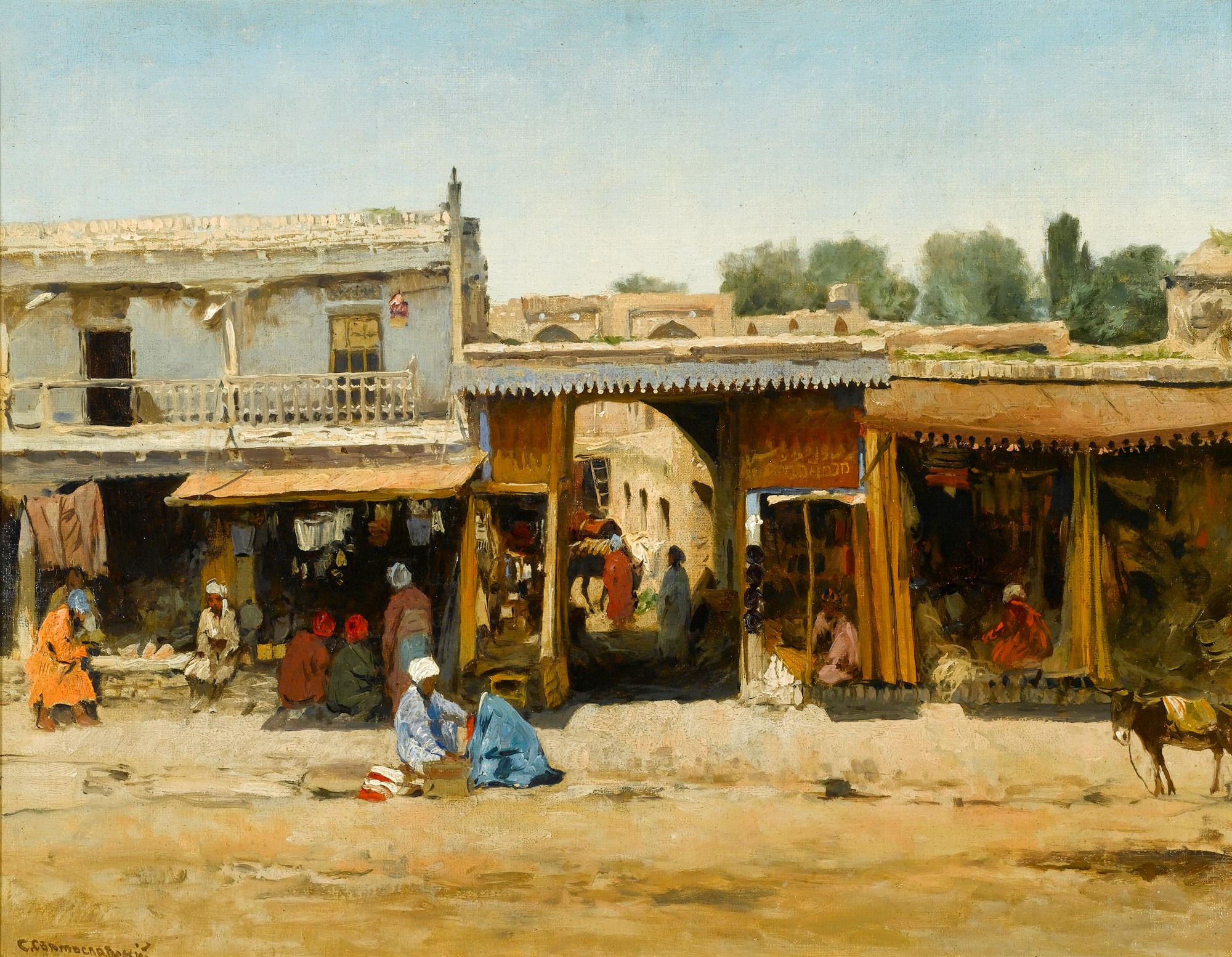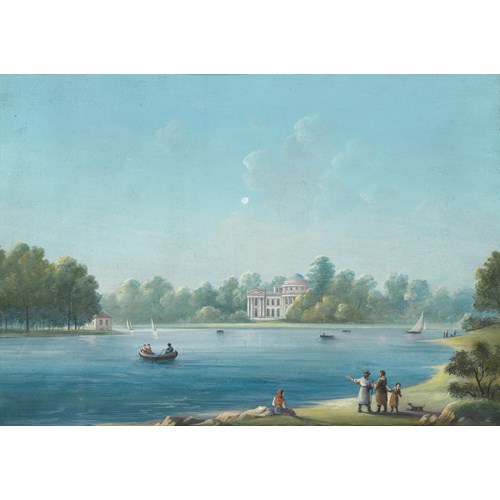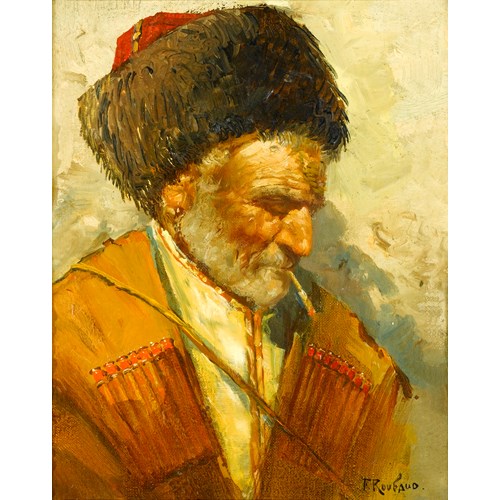Marketplace
Oriental Market Scene
Sergei Ivanovich Svetoslavsky
Oriental Market Scene
Epoque 1850-1900, 19th century, 20th century
Origine Ukraine
Medium Oil on canvas laid on board
Dimension 47.3 x 62.3 cm (18⁵/₈ x 24¹/₂ inches)
Oriental Market Scene is divided into three vertical planes, each delineated into box-like shapes by the open fronted edifices. In the left hand section, a cobbler shapes a shoe, a leather skin hanging from his shop front ready for cutting. To his right, three figures crowd around the neighbouring merchant’s shop, eyeing the goods suspended from the ceiling. The central arched portal pulls the viewer’s eye to an area beyond, adding depth to the frieze like composition. The abundant delights on offer in this street market continue; a shop sign above a doorway in Arabic script draws our eye down to four cobalt blue rounded plates that are displayed in a vertical line, inviting buyers to venture inside to view the full range of pottery on sale. To the right a figure appears to be preparing some woollen yarn, possibly for weaving or dyeing.
The painting is then divided into three horizontal bands, with the busy subject matter of the market scene filling the central pane. Crammed full of numerous figures and objects, it covers the main area of canvas and teems with a diversity of colour, from the rusty burnt saffron colours of the signs on either side of the central arch, to the scarlet red headdresses and multitude of shades used to colour the various gowns. The upper area is predominately architectural, providing yet another area of canvas to intrigue the viewer, from the dilapidated stone blue frontage of the buildings on the left, to the more majestic arched portals in the distant background. Both the busy central and upper bands are then balanced carefully by the simplicity of the sandy colour in the lower part of the canvas, which is broken only by the lone donkey and a figure in blue.
Sergei Ivanovich Svetoslavsky travelled to Central Asia on two occasions, ‘fulfilling his nostalgic desire to collect and capture the life of Caucasian and Turkestan folk on the outskirts of the Russian Empire in artefacts and images’.¹ In another work from his travels, Asian Courtyard, (Private collection) he captures the same hot, dusty atmosphere that is also such a feature of Oriental Market Scene. Both works show a concern with capturing the sights and sounds of Central Asia, the sensation of being in this exotic location. Executed with expressive free-flowing brushstrokes, typical of Svetoslavsky’s work, both paintings convey the beautiful but alien nature of Oriental daily life, emphasising ‘the everyday intensity of Turkestan, garbed in dazzlingly painted colours, every detail beaming forth the desire to witness the life around him’.²
Svetoslavsky travelled from Kiev to attend the Moscow School of Painting from 1874 to 1882 and successfully passed his courses, studying with Aleksej Kondratevic Savrasov, Vasilij Grigorievic Perov and Vasili Dimitrevich Polenov. His first independent work was From the Window of the Moscow School of Painting, 1878, and greatly impressed not only his tutors, but also the great collector of Russian painting, Pavel Tretyakov, who acquired the work for his collection. He made two trips to Central Asia, in 1899 and again in 1910, and the region made a lasting impression on him. As he himself said ‘this is where the real sun is! We do not know how to depict the sun. Central Asian sun should be painted so that your eyes hurt from it’, and Oriental Market Place conveys this belief.
¹ Russia’s Unknown Orient: Orientalist Painting 1850-1920, ed. Wageman, P., & Kouteinikova, I., (exh. cat. Groninger Museum, Dec 2010 – May 2011), p.219.
² Ibid.
The painting is then divided into three horizontal bands, with the busy subject matter of the market scene filling the central pane. Crammed full of numerous figures and objects, it covers the main area of canvas and teems with a diversity of colour, from the rusty burnt saffron colours of the signs on either side of the central arch, to the scarlet red headdresses and multitude of shades used to colour the various gowns. The upper area is predominately architectural, providing yet another area of canvas to intrigue the viewer, from the dilapidated stone blue frontage of the buildings on the left, to the more majestic arched portals in the distant background. Both the busy central and upper bands are then balanced carefully by the simplicity of the sandy colour in the lower part of the canvas, which is broken only by the lone donkey and a figure in blue.
Sergei Ivanovich Svetoslavsky travelled to Central Asia on two occasions, ‘fulfilling his nostalgic desire to collect and capture the life of Caucasian and Turkestan folk on the outskirts of the Russian Empire in artefacts and images’.¹ In another work from his travels, Asian Courtyard, (Private collection) he captures the same hot, dusty atmosphere that is also such a feature of Oriental Market Scene. Both works show a concern with capturing the sights and sounds of Central Asia, the sensation of being in this exotic location. Executed with expressive free-flowing brushstrokes, typical of Svetoslavsky’s work, both paintings convey the beautiful but alien nature of Oriental daily life, emphasising ‘the everyday intensity of Turkestan, garbed in dazzlingly painted colours, every detail beaming forth the desire to witness the life around him’.²
Svetoslavsky travelled from Kiev to attend the Moscow School of Painting from 1874 to 1882 and successfully passed his courses, studying with Aleksej Kondratevic Savrasov, Vasilij Grigorievic Perov and Vasili Dimitrevich Polenov. His first independent work was From the Window of the Moscow School of Painting, 1878, and greatly impressed not only his tutors, but also the great collector of Russian painting, Pavel Tretyakov, who acquired the work for his collection. He made two trips to Central Asia, in 1899 and again in 1910, and the region made a lasting impression on him. As he himself said ‘this is where the real sun is! We do not know how to depict the sun. Central Asian sun should be painted so that your eyes hurt from it’, and Oriental Market Place conveys this belief.
¹ Russia’s Unknown Orient: Orientalist Painting 1850-1920, ed. Wageman, P., & Kouteinikova, I., (exh. cat. Groninger Museum, Dec 2010 – May 2011), p.219.
² Ibid.
Epoque: 1850-1900, 19th century, 20th century
Origine: Ukraine
Medium: Oil on canvas laid on board
Signature: Signed in Cyrillic (lower left)
Dimension: 47.3 x 62.3 cm (18⁵/₈ x 24¹/₂ inches)
Exhibition: Russia’s Unknown Orient: Orientalist Painting 1850-1920, Groninger Museum, December 2010 - May 2011, pp. 31 (illustrated) & 219
Plus d'œuvres d'art de la Galerie









